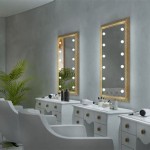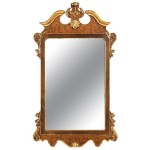Inlaid Bone Mirror: A Detailed Exploration of Art and Craftsmanship
Inlaid bone mirrors represent a significant intersection of art, craftsmanship, and cultural expression. These decorative objects, characterized by the application of intricately carved and meticulously placed bone fragments onto a variety of surfaces, offer a glimpse into the historical practices, aesthetic preferences, and technical skills of various cultures across different eras. The creation of an inlaid bone mirror is a complex process, demanding a high degree of skill, patience, and artistic vision.
The appeal of inlaid bone mirrors stems from several factors. The natural beauty of bone, with its subtle variations in color and texture, provides a visually appealing base material. The meticulous carving and arrangement of bone pieces into intricate patterns and designs further enhance the aesthetic value. Moreover, the contrast between the bone inlays and the background surface, often made of wood, metal, or other materials, creates a striking visual effect. The historical significance and cultural associations of inlaid bone mirrors also contribute to their enduring fascination, making them highly sought-after collectibles and decorative items.
Understanding the intricacies of inlaid bone mirrors requires examining the materials used, the techniques employed, and the cultural contexts in which they were created. This article will delve into these aspects, providing a comprehensive overview of the history, construction, and appreciation of these unique artistic objects.
Key Point 1: Materials and Preparation in Inlaid Bone Mirror Creation
The primary material in the creation of an inlaid bone mirror is, of course, bone. However, the specific type of bone used, its source, and the preparatory processes it undergoes significantly impact the final product. Traditionally, animal bones, particularly those from cattle, camels, and elephants (where legally and ethically sourced), have been the most common choices. The availability of specific bone types often depended on the geographical location and the prevailing cultural practices of the artisans.
The selection of bone is a crucial step. Artisans typically look for bones that are dense, strong, and free from cracks or imperfections. The bones are then carefully cleaned to remove any residual tissue and fat. This process often involves boiling or soaking the bones in water and detergents. Once cleaned, the bones need to be thoroughly dried to prevent warping or cracking. The drying process must be gradual and controlled to ensure the structural integrity of the bone.
After drying, the bones are cut into smaller pieces or sheets, depending on the desired design. This process requires specialized tools, such as saws and chisels. The cutting process must be precise to ensure that the bone pieces fit together seamlessly. The size and shape of the bone pieces can vary greatly, from small, intricate tesserae used in mosaic-like patterns to larger, more elaborate carvings that form the focal point of the design. The process of preparing bone for inlay work is labor-intensive and requires considerable skill and experience.
Beyond bone, other materials play essential roles in the construction of inlaid bone mirrors. The backing or frame of the mirror can be made of wood, metal, or other durable materials. The choice of backing material depends on the desired aesthetic, the structural requirements of the mirror, and the available resources. Adhesives are also crucial for securing the bone inlays to the backing surface. Historically, artisans used natural adhesives derived from animal glues or plant resins. Modern adhesives, such as epoxy resins, are also used in contemporary inlaid bone mirrors.
The mirror itself is another critical component. The quality of the mirror glass directly impacts the overall appearance and functionality of the mirror. The glass is typically cut to fit the frame and secured in place using glues or other fastening mechanisms. The mirror glass often also needs to be bevelled around the edge for an appealing look.
Key Point 2: Techniques and Craftsmanship Involved
The creation of an inlaid bone mirror involves a range of techniques and skills, from carving and shaping the bone pieces to carefully arranging and adhering them to the backing surface. The specific techniques employed can vary depending on the style of inlay, the complexity of the design, and the tools and materials available to the artisan.
One of the most important techniques is bone carving. Artisans use a variety of tools, such as chisels, knives, and files, to shape the bone pieces into the desired forms. The carving process can be quite intricate, especially when creating detailed patterns or figurative designs. The skill of the carver is evident in the precision and detail of the carving, as well as the overall aesthetic quality of the design.
The arrangement of the bone pieces is another critical aspect of the inlay process. Artisans carefully arrange the bone pieces on the backing surface, creating a cohesive and visually appealing pattern. The arrangement must be precise to ensure that the bone pieces fit together seamlessly and that the overall design is balanced and harmonious. This often involves creating detailed templates and diagrams to ensure accuracy.
Adhering the bone pieces to the backing surface requires careful attention to detail. The adhesive must be applied evenly and in the correct amount to ensure a strong and durable bond. The bone pieces must be pressed firmly into place and held until the adhesive has set. This process often involves using clamps or other tools to secure the bone pieces while the adhesive dries. Excess adhesive must be carefully removed to avoid marring the appearance of the inlay.
Finishing is a crucial step in the creation of an inlaid bone mirror. The surface of the inlay is typically polished to enhance its luster and smoothness. This process can involve using a variety of abrasives, such as sandpaper or polishing compounds. The finishing process also helps to protect the bone inlay from damage and wear. A protective coating, such as wax or varnish, may be applied to further enhance the durability and appearance of the inlay.
The level of craftsmanship involved in creating an inlaid bone mirror is truly remarkable. The skills and techniques required to carve, arrange, and adhere the bone pieces demand a high degree of expertise and patience. The finished product is a testament to the artistry and dedication of the artisans who create these unique and beautiful objects.
Key Point 3: Cultural Significance and Historical Context
Inlaid bone mirrors are not merely decorative objects; they also hold significant cultural meaning and reflect the historical contexts in which they were created. The motifs and designs used in inlaid bone mirrors often carry symbolic or religious significance, reflecting the beliefs and values of the cultures that produced them. The materials used, the techniques employed, and the overall aesthetic style of the mirrors also provide insights into the economic conditions, social hierarchies, and artistic traditions of different societies.
Historically, inlaid bone work has been practiced in various cultures around the world, including India, Egypt, and parts of Europe. In India, for example, inlaid bone work is an ancient craft that has been practiced for centuries. Indian artisans are known for their intricate and elaborate designs, which often feature floral motifs, geometric patterns, and depictions of animals and mythological figures. The use of inlaid bone in India is often associated with royalty and religious institutions, reflecting the high status and cultural significance of the craft.
In ancient Egypt, bone and ivory were used extensively in decorative arts, including the creation of inlaid objects. Egyptian artisans were skilled at carving intricate designs into bone and ivory, which were then used to embellish furniture, boxes, and other luxury items. The motifs used in Egyptian inlaid bone work often reflected the religious beliefs and symbolic imagery of the ancient Egyptians.
In Europe, inlaid bone work has been practiced since the Middle Ages. European artisans often used bone and ivory to create decorative inlays for furniture, musical instruments, and other objects. The designs used in European inlaid bone work often reflected the aesthetic styles of the period, such as Gothic, Renaissance, and Baroque. During the colonial era, bone and ivory were obtained from various parts of the world and used to create inlaid objects for export and trade.
The cultural significance of inlaid bone mirrors extends beyond their aesthetic value. These objects serve as tangible links to the past, providing insights into the artistic traditions, cultural beliefs, and historical circumstances of different societies. By studying and preserving inlaid bone mirrors, we can gain a deeper understanding and appreciation of the rich and diverse heritage of human craftsmanship.
The creation and appreciation of inlaid bone mirrors continue to evolve in the modern era. Contemporary artisans are exploring new techniques and materials, pushing the boundaries of traditional inlay work. The demand for inlaid bone mirrors remains strong, both among collectors and individuals who appreciate the beauty and craftsmanship of these unique artistic objects.

Waterfall Inlay Mirror Bone Targua Wall

Striped Bone Inlay Mirror Elephanta Exports

Targua Bone Inlay Mirror Elephanta Exports

Roman Rectangular Bone Inlay Wall Mirror Reviews Crate Barrel

Antique Bone Inlay Mirror Frame Handcrafted Wall Mounted For Bedroom

Grace Bone Inlay Mirror 32 Reviews Cb2

Bone Inlay Octagon Modish Mirror Frame White Flower Petal Pattern 50x2x75cm Made To Order And Mother Of Pearl Furniture

Bone Inlay Mirror Anthropologie

Caraway Modern Bone Inlay Full Length Floor Mirror 48 X78 Reviews Cb2

Buy Gray Bone Inlay Designer Mirror Frame With Free








